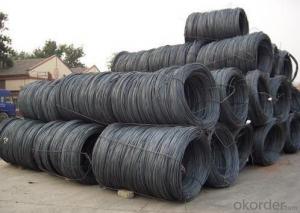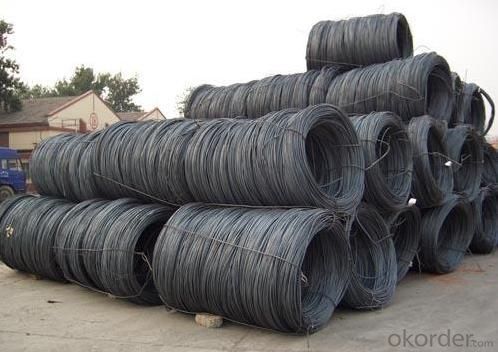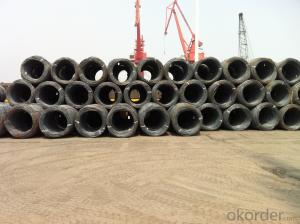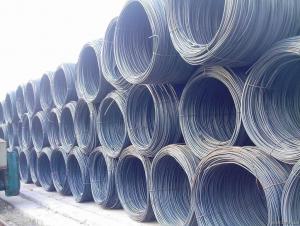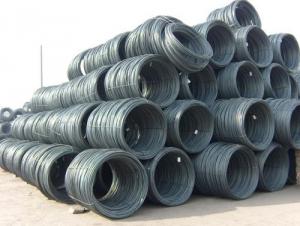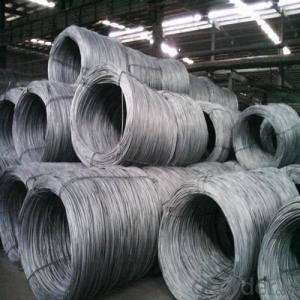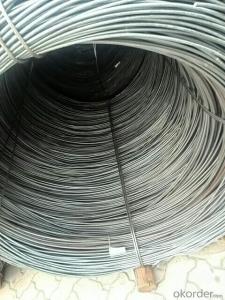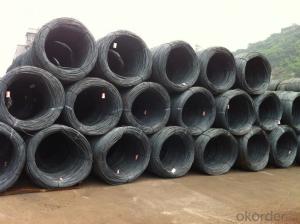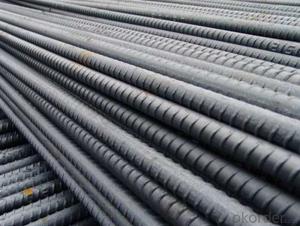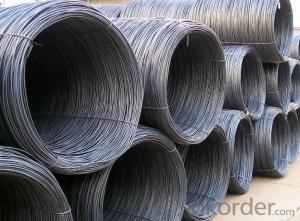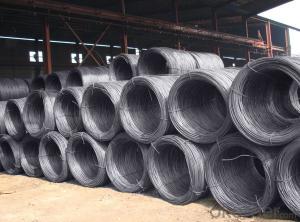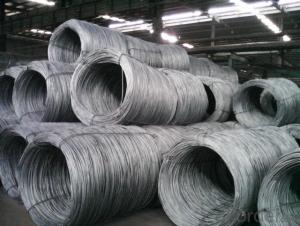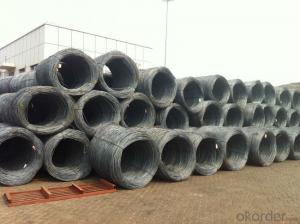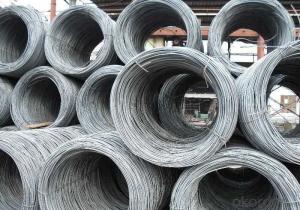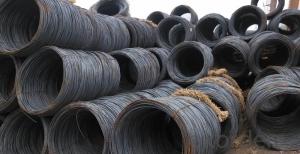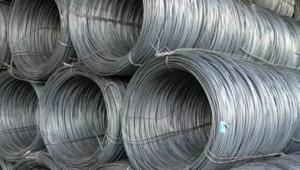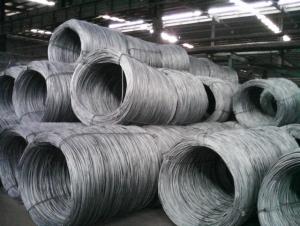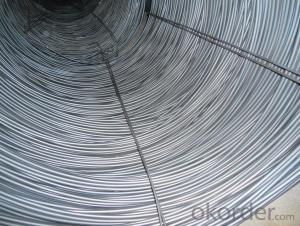High Quality Steel Wire Rod SAE1008 8.0mm
- Loading Port:
- Tianjin
- Payment Terms:
- TT or LC
- Min Order Qty:
- 50 m.t
- Supply Capability:
- 10000 m.t/month
OKorder Service Pledge
OKorder Financial Service
You Might Also Like
High Quality Steel Wire Rod SAE1008 8.0mm
Product Description:
Specifications of Wire Rod SAE1008:
Grade: SAE1008 Standard: ASTM
Diameter: 8.0mm
Alloy or Not: Alloy
Technique: Hot Rolled Place of Origin: China Mainland
Chemical Composition:
Please kindly find our chemistry of our material based on SAE1008 as below for your reference:
Grade | Chemical Composition (%) | |||||
C | Mn | S | P | Si | ||
SAE1008 | 0.10max | 0.32max | 0.045max | 0.040max | 0.30max | |
Mechanical properties | ||||||
Yield strength(N/mm2) | Tensile strength(N/mm2) | Elongation (%) | ||||
≥195 | 350-380 | ≥32 | ||||
Usage and Applications of High Quality Steel Wire Rod SAE1008 8.0mm:
After hot-rolled the products shaped into coil and delivery as finished product, including round, square,rectangular, hexagonal and so on. Since most of the products are round, it is generally called wire rod. Carbon steel wire rod is widely used in construction and manufacturing. Carbon steel wire rod is mainly used for reinforcement of reinforced concrete and welded structure or reprocessed (roberts , nail, etc.) materials, especially used to produce wire drawing, welding electrode, nails, spring, electronic, precise machinery parts and so on.
Packaging & Delivery of High Quality Steel Wire Rod SAE1008 8.0mm:
Packaging Detail: products are packed in coil and then shipped by container or bulk vessel
Each coil weight: About 2.05MT
Delivery Detail: within 45 days after received deposit or LC.
Label: to be specified by customer, generally, each bundle has 1-2 labels
Trade terms: FOB, CFR, CIF
FAQ:
Q1: Why buy Materials & Equipment from OKorder.com?
A1: All products offered byOKorder.com are carefully selected from China's most reliable manufacturing enterprises. Through its ISO certifications, OKorder.com adheres to the highest standards and a commitment to supply chain safety and customer satisfaction.
Q2: How do we guarantee the quality of our products?
A2: We have established an advanced quality management system which conducts strict quality tests at every step, from raw materials to the final product. At the same time, we provide extensive follow-up service assurances as required.
Q3: How soon can we receive the product after purchase?
A3: Within three days of placing an order, we will arrange production. The shipping date is dependent upon the quatity, how many sizes you want and the plan of production, but is typically 1 month to 2 month days from the beginning of production.
Images of High Quality Steel Wire Rod SAE1008 8.0mm:
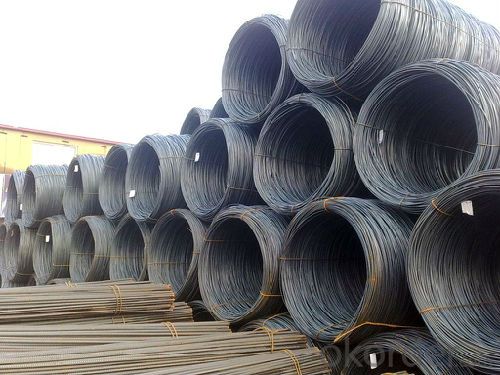
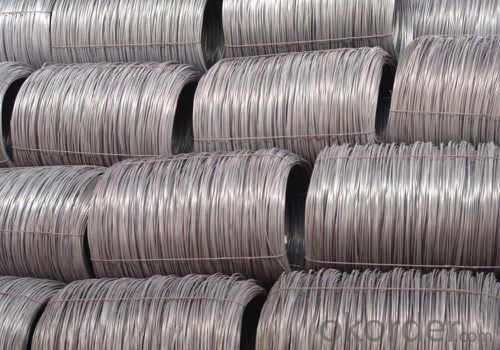
*If you would like to get our price, please inform us the size, standard/material and quantity. Thank you very much for your attention.
- Q: How is steel wire rod used in the manufacturing of wire for suspension systems in vehicles?
- Steel wire rod is an essential material in the manufacturing of wire for suspension systems in vehicles. It serves as the primary raw material from which the wire is drawn and shaped. The steel wire rod is carefully selected for its high strength and durability properties, ensuring that the resulting wire can withstand the heavy loads and stresses encountered in suspension systems. Through various mechanical processes such as drawing, annealing, and coating, the steel wire rod is transformed into high-quality wire that is then used to construct springs, coils, and other components of the suspension system. Ultimately, steel wire rod plays a crucial role in providing stability, support, and reliable performance to the suspension systems of vehicles.
- Q: What are the different types of wire rods for reinforcement made from steel wire rod?
- There are several different types of wire rods for reinforcement made from steel wire rod, including plain wire rods, deformed wire rods, and cold-drawn wire rods. Plain wire rods are smooth and have no surface deformations, while deformed wire rods have ridges or bumps along their surface to provide better grip and adhesion with concrete. Cold-drawn wire rods are manufactured through a process of drawing the wire through a series of dies, resulting in a smoother and more uniform product with enhanced strength and flexibility.
- Q: What are the common applications of pre-stressed concrete steel wire rod?
- Pre-stressed concrete steel wire rods are widely used in various applications due to their high strength and durability. Some of the common applications of pre-stressed concrete steel wire rods are: 1. Buildings and Infrastructure: Pre-stressed concrete steel wire rods are commonly used in the construction of buildings, bridges, highways, and other infrastructure projects. They provide added strength and load-bearing capacity to the structures, making them resistant to bending, cracking, and other forms of structural failure. 2. Post-tensioning Systems: Pre-stressed concrete steel wire rods are extensively used in post-tensioning systems. These systems involve the insertion of pre-stressed steel wire rods into concrete structures and then applying tension to them. This process helps to counteract the tensile forces that concrete structures experience, thereby improving their overall strength and durability. 3. Precast Concrete Products: Pre-stressed concrete steel wire rods are also used in the production of precast concrete products such as beams, columns, slabs, and walls. By incorporating pre-stressed steel wire rods during the manufacturing process, these products gain enhanced strength and resistance to cracking, allowing for longer spans and thinner sections. 4. Retaining Walls: Pre-stressed concrete steel wire rods play a crucial role in the construction of retaining walls. These walls are designed to retain soil and prevent erosion. By integrating pre-stressed steel wire rods into the concrete structure, the retaining walls become more robust, ensuring stability and preventing any potential failure due to the pressure exerted by the retained soil. 5. Seismic Resistant Structures: Pre-stressed concrete steel wire rods are especially valuable in seismic regions where earthquakes are a concern. By incorporating pre-stressed steel wire rods into the concrete elements of buildings and infrastructure, their ability to withstand seismic forces is significantly increased. This helps to minimize damage and ensure the safety of occupants during earthquakes. Overall, the common applications of pre-stressed concrete steel wire rods encompass a wide range of construction projects, where their strength, durability, and ability to withstand various forces are essential.
- Q: How is steel wire rod used in the manufacturing of wire for electrical heating cables?
- Steel wire rod is an indispensable element in the wire manufacturing process for electrical heating cables. The wire rod acts as the main raw material that undergoes different treatments and changes to produce the final wire for electrical heating cables. To start with, the steel wire rod is typically made from low-carbon steel, which possesses exceptional electrical conductivity and resistance to heat. This makes it a perfect material for electrical heating cables as it can efficiently conduct electricity and endure the high temperatures generated by the cables. The initial step in the manufacturing process involves hot rolling the steel wire rod into a thin strip, which is then cold drawn to achieve the desired wire diameter. This cold drawing process gives the wire high tensile strength and flexibility, ensuring its ability to withstand stress and strain in various applications. Once the wire is formed, it undergoes a series of heat treatments to enhance its electrical conductivity and heat resistance. This may include annealing, where the wire is heated and slowly cooled to relieve internal stresses and improve its ductility. Additionally, the wire may undergo galvanization, a process in which a protective layer of zinc is applied to enhance its resistance to corrosion. After the heat treatments, the wire is further processed to meet the required specifications for electrical heating cables. This may involve additional drawing processes to achieve the desired diameter and surface finish. The wire is then wound onto spools or coils, ready to be used in the manufacturing of electrical heating cables. In the final stage of the manufacturing process, the steel wire is incorporated into the construction of electrical heating cables. This usually involves combining the wire with other materials, such as insulation and protective sheathing, to ensure the safety and functionality of the cables. Overall, steel wire rods have a vital role in the manufacture of wire for electrical heating cables. Its outstanding electrical conductivity, heat resistance, and strength make it an ideal material for this application. Through different treatments and processes, the steel wire rod is transformed into a high-quality wire that can efficiently conduct electricity and withstand the demanding conditions of electrical heating systems.
- Q: What are the standard surface roughness requirements for steel wire rod?
- The standard surface roughness requirements for steel wire rod vary depending on the specific application and industry standards. However, in general, steel wire rod is expected to have a smooth and uniform surface with minimal imperfections. For construction purposes, such as reinforcing concrete structures, the surface roughness requirements are relatively lenient. It is common for steel wire rod used in construction to have a surface roughness of Ra 3.2 to 6.3 micrometers (125 to 250 microinches). In contrast, for more demanding applications like precision engineering or automotive manufacturing, higher surface quality is required. In these cases, the surface roughness requirements for steel wire rod are typically stricter, with a range of Ra 0.8 to 1.6 micrometers (32 to 63 microinches). It is important to note that these values are not universal and can vary depending on specific industry standards or customer preferences. Manufacturers and suppliers of steel wire rod typically provide detailed specifications and standards that need to be met for specific applications, ensuring that the required surface roughness is achieved.
- Q: What are the main factors affecting the market research of steel wire rod?
- The main factors affecting the market research of steel wire rod include supply and demand dynamics, price fluctuations, technological advancements, industry regulations, and the impact of global economic conditions. Additionally, factors like raw material availability, competition from alternative materials, and changing consumer preferences also play a significant role in shaping the market research of steel wire rod.
- Q: What are the main factors affecting the market branding of steel wire rod?
- The main factors affecting the market branding of steel wire rod include price, quality, reputation of the manufacturer, customer perception and demand, technological advancements, competition, and industry regulations.
- Q: What are the different types of steel wire rod coatings used for increased hardness?
- There are several different types of steel wire rod coatings that are used to increase hardness. These coatings are applied to the surface of the wire rod to enhance its strength, durability, and resistance to wear. Some of the commonly used coatings include: 1. Galvanized Coating: This is one of the most widely used coatings for steel wire rods. It involves applying a layer of zinc to the surface of the rod through a hot-dip or electroplating process. The zinc coating provides excellent corrosion resistance and increases the hardness of the wire rod. 2. Zinc-Aluminum Coating: This coating is a combination of zinc and aluminum, which provides enhanced hardness and corrosion resistance. It is applied through a hot-dip process, resulting in a coating that is more durable and longer-lasting compared to a regular galvanized coating. 3. Copper Coating: Copper coatings are used to improve the hardness and electrical conductivity of the steel wire rod. This type of coating is commonly employed in applications where electrical conductivity is crucial, such as in electrical wiring and grounding applications. 4. Nickel Coating: Nickel coatings are known for their excellent hardness and resistance to corrosion. These coatings are often applied to steel wire rods used in high-stress applications where wear resistance is critical, such as in springs, cables, and fasteners. 5. Chrome Coating: Chrome coatings are used to increase the hardness and wear resistance of steel wire rods. The process involves electroplating the rod with a layer of chromium, which provides excellent resistance to abrasion and corrosion. 6. Ceramic Coating: Ceramic coatings are relatively new in the field of steel wire rod coatings. These coatings consist of ceramic particles that are applied to the surface of the wire rod using specialized techniques like plasma spraying. Ceramic coatings offer exceptional hardness, wear resistance, and thermal stability, making them suitable for demanding applications such as cutting tools and industrial machinery. It is important to note that the selection of the appropriate coating for a specific application depends on factors such as the intended use, environmental conditions, and desired performance characteristics. Consulting with a materials engineer or coating specialist would be beneficial in determining the most suitable coating for increased hardness in steel wire rods.
- Q: What are the different wire drawing lubricants used for steel wire rod?
- There are several different wire drawing lubricants used for steel wire rod, including soap-based lubricants, oil-based lubricants, and synthetic lubricants. Soap-based lubricants are commonly used for mild steel wire rod, as they provide good lubrication and cooling properties. Oil-based lubricants are often used for high carbon and alloy steel wire rod, as they offer better lubrication and reduce friction during the drawing process. Synthetic lubricants, such as water-based polymer lubricants, are also used to improve surface finish and reduce wear on the wire rod during drawing.
- Q: How is the steel wire rod market segmented by application?
- The steel wire rod market is segmented by application into construction, automotive, industrial machinery, and others.
Send your message to us
High Quality Steel Wire Rod SAE1008 8.0mm
- Loading Port:
- Tianjin
- Payment Terms:
- TT or LC
- Min Order Qty:
- 50 m.t
- Supply Capability:
- 10000 m.t/month
OKorder Service Pledge
OKorder Financial Service
Similar products
Hot products
Hot Searches
Related keywords

